Nomination Forms Toolkit – Wales
This toolkit will help you fill out your nomination forms for Welsh Council Elections. This is the legal paperwork you must complete in order to stand in elections as a Liberal Democrat candidate on the ballot paper.
You can download your full pack of nomination papers from the Electoral Commission website here.
You should check your eligibility to stand in the forthcoming election. There are a number of criteria that make you eligible to stand, and a number of criteria that can also disqualify you from standing. You can check your eligibility with the Electoral Commission’s Guidance for Candidate’s and Agents here.
You should also arrange a date to go into the Elections Office at your Local Council a few days in advance of the deadline for submitting your nomination forms – and let them check that all your forms are correctly filled in. This will give you time to put right any errors before the deadline.
This toolkit will take you through each form you need to fill in as follows. You should complete your forms in BLACK INK and make efforts to make your writing as legible as possible.
1a: Nomination Paper
1b: Home Address Form
2: Certificate of Authorisation
3: Request for a Party Emblem
4: Notification of Election Agent
1a: Nomination Paper
Section 1 of your Nomination paper is where you fill in details about your ward, council and polling day date.
First of all write the name of your Council in the first box at the top of the page. Then write the name of your Electoral Ward in the box immediately below. Finally write the Polling Day date in the third box right below.
Section 2 of the Nomination Paper is where you fill out your personal details as a candidate.
You must fill out your surname and forenames as they appear on the electoral register. You may use a title; for example, if your actual name is Joseph Smith but your hereditary title is Joseph Avon, you can use the name Joseph Avon as your full name.
You are able to give a commonly used name – for instance, a candidate named Robert may reasonably appear on the ballot as Bob. The returning officer has the right to disallow any name which is deemed to be offensive or they feel is aiming to deceive the electorate. Similarly, a person known by a surname other than their legal surname (for instance, their surname before marriage which they keep professionally) may also ask for this commonly used surname to appear on the ballot.
Finally provide your Date of Birth in the final box of this section.
Section 3 of the Nomination Paper is where you give the party name.
This must match the party name you give on your Certificate of Authorisation form.
In Wales you can choose the party name, or an alternative description. You may choose a description in English, in Welsh, or both, so long as the Certificate of Authorisation matches.
If you use the party name you may choose the primary name (which is in English), the alternative name ( which is in Welsh), or both. You can also add Wales / Welsh / Cymru / Cymreig to the names
Primary name: Liberal Democrats
Alternative name: Democratiaid Rhyddfrydol
So, you can have: Welsh Liberal Democrats, or Democratiaid Rhyddfrydol Cymru, or Welsh Liberal Democrats Democratiaid Rhyddfrydol Cymru.
If you are using the latter, you should check with your returning officer on which order (English/Welsh or Welsh/English) they would accept.
The alternative names you can use, along with their translations, are
- Welsh Liberal Democrats – Democratiaid Rhyddfrydol Cymru (this is a single name and has no translation)
- Welsh Liberal Democrats (translation Democratiaid Rhyddfrydol Cymru)
- Welsh Liberal Democrats Focus Team (translation Tîm Ffocws Democratiaid Rhyddfrydol Cymru)
- Liberal Democrat (translation Democratiaid Rhyddfrydol)
- Liberal Democrats – For a fair deal (translation Tîm Ffocws)
- Liberal Democrat Focus Team (translation Tîm Ffocws y Democratiaid Rhyddfrydol)
- Focus Team (this is a single name and has no translation)
Section 4 of the Nomination Paper is the section on which you must indicate your membership of a political party.
If you are a member of the Liberal Democrats you should tick the box next to the ‘Yes’ answer to the question ‘Have you been a member of any registered political party at any time during the period of 12 months ending on the day on which the notice of election is published’.
You do not need to complete the further parts of this section if you have included a permitted Liberal Democrat party description in Section 3 of the form (see above) and you have not been a member of another political party in the preceding 12 months.
If you have been a member of another political party in the previous 12 months you must complete the table further down Section 4 – listing the registered names of each political party you have been a member of and the dates during which you were a member within that 12 months.
You can find the official registrations of each political party on the electoral commission website here
Section 5 of the Nomination Paper is known as the Declaration.
This is where you confirm the criteria you meet in order to qualify to stand for election – either by confirming that you live within the Council area in which you are standing or by demonstrating that you work / own property / exist on the electoral register in that Council area.
In this section you only need to tick the boxes next to the criteria that apply to you and cross through the criteria that do not – as demonstrated on the example form below.
You should then sign and date the declaration section of your Nomination Papers.
Section 6 of the Nomination Paper requires your signature and the signature of a witness
Sign and date the form in the boxes provided. Your witness must then print their name and sign underneath. You must get the same witness to sign all of your nomination papers.
An example completed set of Nomination Paper forms is below:
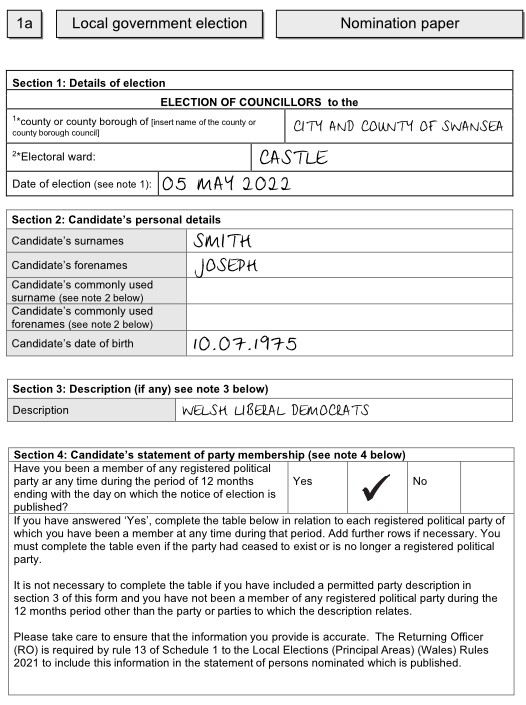
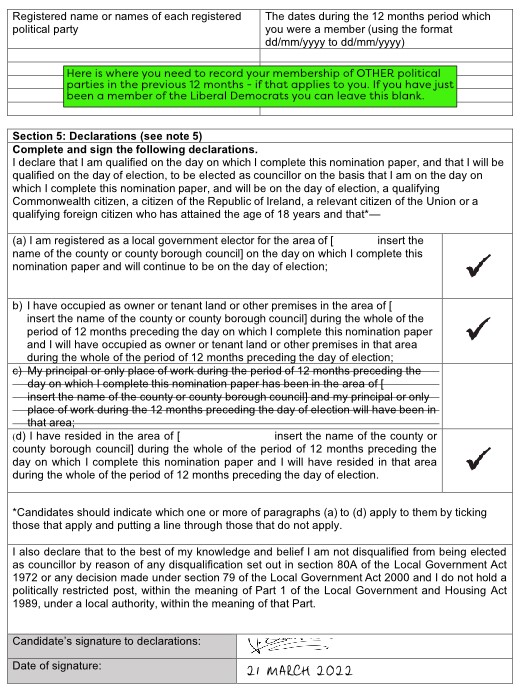
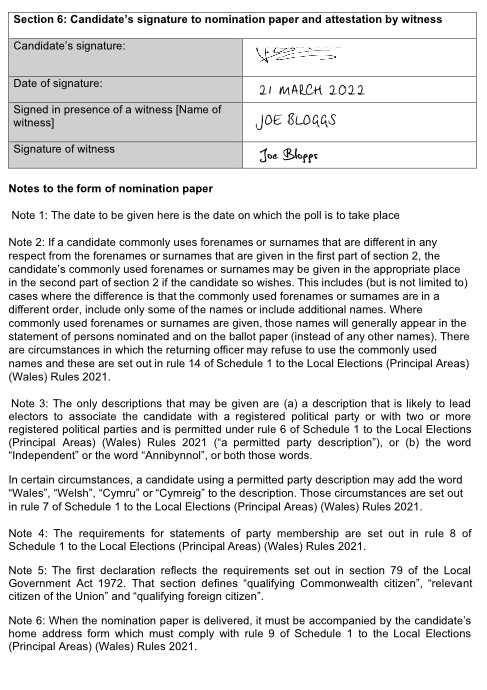
1b: Home Address Form
The Home Address Form is where you provide evidence of your eligibility to stand – either by demonstrating that you live within the Council area in which you are standing or by demonstrating that you work / own property / exist on the electoral register in that Council area.
You must fill out your home address as part of this form. All candidates must fill out Part 1 of this form. Part 2 of this form only needs to be filled out by candidates who do not wish for their home address to appear on ballot papers, notice of poll and statement of persons nominated.
The first section of this form is identical to the first section of the Nomination Paper form above – in which you should enter the County or County Borough Name, the Electoral Ward and then the Polling Day date.
Part 1 of this form starts with you needing to enter your full name and home address. Your full name must be your registered name as it appears on the electoral register (rather than your commonly used name) and your home address must be given in full.
The next section of the form is where you add your ‘Qualifying Addresses’ that relate to the Qualifications you selected on the Declaration section (Section 5) of your 1a: Nomination Form above. Add the full address for each criteria that you meet.
The final action required on Part 1 of this form is for a witness to write their full name and home address in the relevant boxes. This must be the same witness that signed your Nomination Form above.
An example completed 1b: Home Address Form is below:
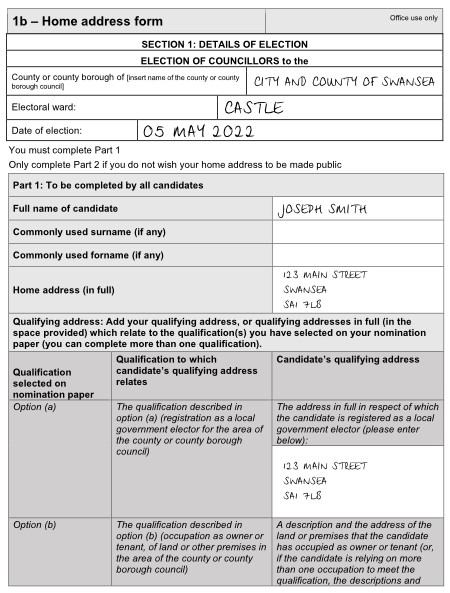
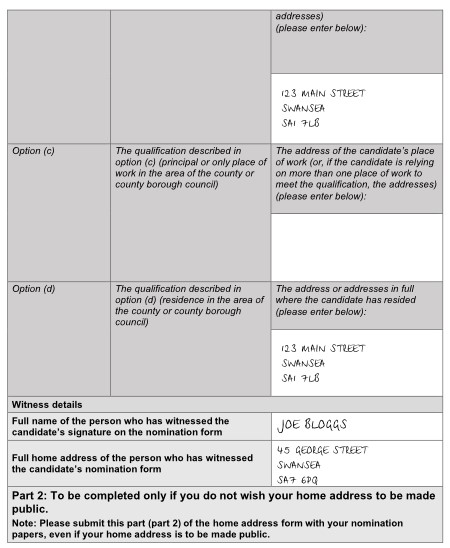
If you wish for your home address to be withheld from the public – so that it will not appear on the ballot papers, notice of poll or statement of persons nominated – you must complete Part 2 of the Home Address form in your nomination pack and physically submit it with your other nomination paperwork.
If you are happy with your home address being published on ballot papers you don’t need to complete or submit this form.
2: Certificate of Authorisation
This is the form that confirms you have permission to stand for the Liberal Democrats. As you are standing for the Liberal Democrats you must complete this form.
First of all enter the name of the ward you are standing in and the date of the election.
To confirm your permission to stand for the Liberal Democrats this form needs to be signed by the party’s designated nominating officer for your area. You may already know who the Delegated Nominating Officer (DNO) to sign this in your area is – but if you do not you should contact your regional party or Sarah Morris on sarah.morris@libdems.org.uk.
You should then put ‘Liberal Democrats’ or ‘Democratiaid Rhyddfrydol’ in the box for the registered political party.
If you used a different party description on your 1a: Nomination Paper form – for instance ‘Welsh Liberal Democrats’ you must add the exact same description in the next box for party description. If you have just used the ‘Liberal Democrats’ or ‘Democratiaid Rhyddfrydol’ party name as the party description on your 1a: Nomination Paper you can leave this box blank. If the party description on the Nomination Paper and Certificate of Authorisation do not match your paperwork will be invalid.
An example completed 2: Certificate of Authorisation form is below:
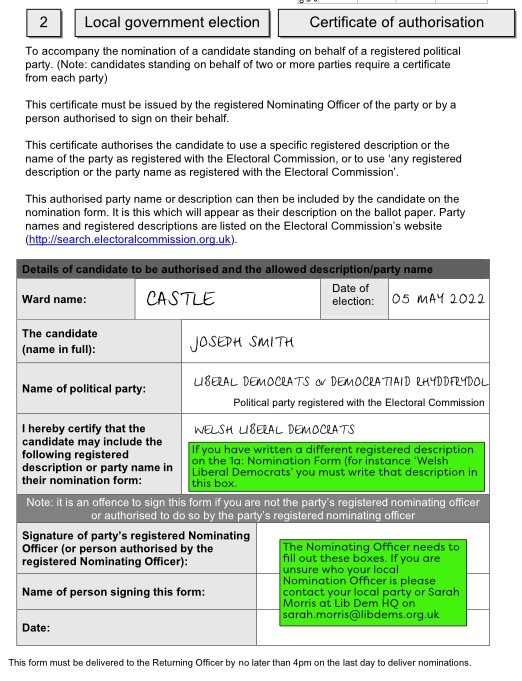
3: Request for a Party Emblem
This form allows the party’s ‘liberty bird’ emblem to appear alongside your name on the ballot paper.
Again, you should fill in the ward name and the date of polling day. You should then give your full name.
When giving the emblem description, use the exact Description. For Wales this is:
- ‘A bird in flight above the words Welsh Lib Dems’ [Emblem ID 107]
An example form for the Welsh party logo is below:
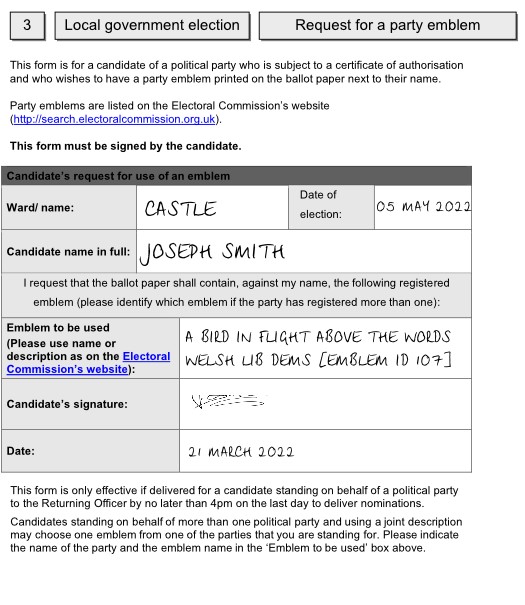
4: Notification of Election Agent
On this page, you can nominate your agent – the person legally responsible for your campaign and the return of your expenses forms after polling day.
All candidates must complete the top section of the form in which you should provide the ward name, the date of election and your candidate name. You also need to specify whether you are appointing an election agent or acting as your own agent. It is recommended that you appoint someone else to act as your election agent.
If you are appointing an election agent you must complete Part A of this form – in which the agents name, address, office address and signature must be provided. You can then ignore Part B of the form.
If you are acting as your own agent you can ignore Part A of this form but you must complete Part B – in which you must give your office and correspondence address.
You will see that you have to provide both your details and those of your agent. Ideally, your agent should have undertaken Election Agent training with the party or ALDC. You should always check with your intended agent before completing any part of this form.
An example Notification of Election Agent form, in which an agent is being appointed, is below:
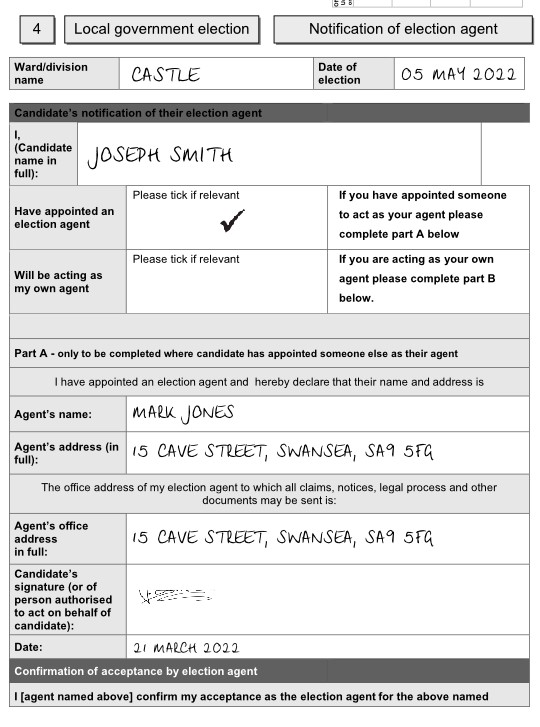
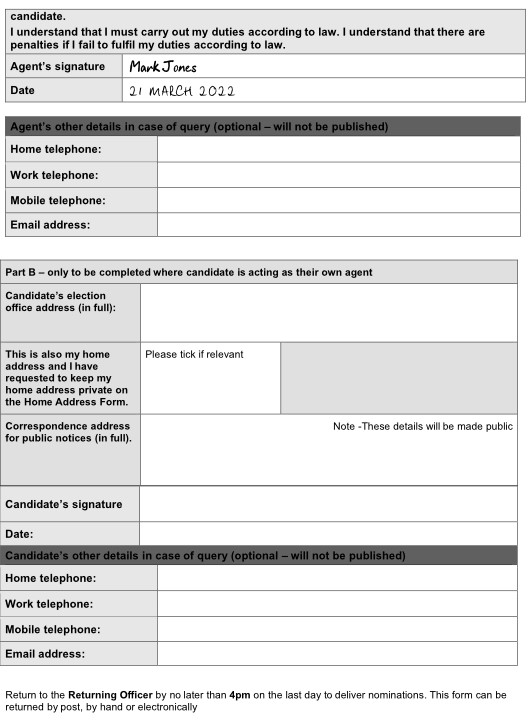
If you need any advice when completing your nominations paperwork you can call our ALDC helpline on 0161 302 7532 – which is open Monday to Friday from 9.30am to 5pm.